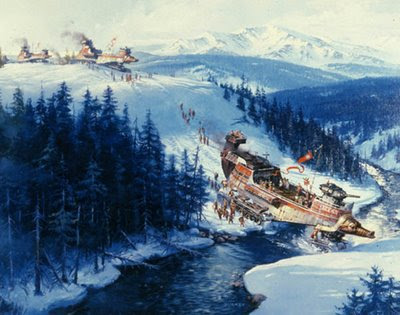 |
| Tobin Larks, Ex-Cygnaran Trencher. |
Journal of Tobin Larks, Caspia, Kingdom
of Cygnar. 608 AR
I found Finnegan
Braddock sitting at the Red Mare, in the dockside district of Caspia. My old captain had told me that Finn’s
Free Company used the Mare as a base when they were in town, and I spotted them
the minute I came in the door. I dropped
my pack and rifle at the bar and walked over to make my introductions.
“Excuse me. Are you Sir Braddock?
The man with the
wild red hair looked up from his ale and looked me over.
“Finn Braddock, at
yer service. No “sirs” involved. What can I do for you?”
“My name is Tobin
Larks, Sir, er, Mr. Braddock, and I am here to apply for a position in your
company. Here are my references, from
previous commanders.” I handed him the thick sheaf of parchment. He took them,
glanced at the seals, and handed them to the man sitting next to him.
“How’d you hear we
were lookin?”
“Dougal Becks of the
city guard is an old friend. He told me,
and I looked you up immediately.”
Braddock laughed
gently to himself. “Is that so? Well, if Dougal likes you, you can’t be all
bad. Godwin?” He glanced at the massive man next to him,
who was looking over the recommendations. The man had a long jagged scar running
from his forehead to his chin, and rubbed at it as he handed the parchment
back.
“Looks good on
paper.”
“Huh,” said
Braddock. “Have a seat kid.” He gestured
to the empty chair opposite him, and glanced at the parchment.
“So you were Cygnar
infantry, huh? Where’d you serve?”
I sat down, and
waived for an ale. “I was a Trencher in
the 3rd Army. Served on the
coast, defending against Cryx.”
“How many actions?”
“I was in the field
two years, and . .”
“How many stand up
fights?” said the huge man next to Braddock.
“Well. Two, sir.
The Havarak Coast siege and the defense of Fuller Village.”
The huge man sipped
his ale. “Fuller Village was a big
fight. So you’ve seen a little action,
huh?”
“Yes sir. A bit.”
The huge man offered
an equally massive hand. “I am sir Godwin Albrecht, formerly of the
Stormblades. “Nice to meet you.”
“It’s an honor, sir.”
“Bah. None of that, kid. Well, Braddock, he seems .
. “
An axe thudded into
the table, and shortly behind it came a massive Trollkin, green-blue hide peeking
out between rough leather and mail.
“Who’s the kid?”
“Kid, meet Grimley
Mossback, lead scout of the Free Company.
What’s the word, Grim? Where’s
Mort?”
“I’m right here, you
ass.” A small green gobber climbed into
the chair next to me, and grabbed my ale.
“Looks like we got a job.”
A woman sitting at
the rough bar walked over and sat down next to Mort. She wore a dark cloak over dark leather, and twin
pistol handles stuck out from beneath the cloak.
“Finally. I am getting bored.”
“The meet went
fine. Couple of local magistrates from a
town about a week west.” Grimley Mossback snatched a pitcher of ale from a
passing waitress and took a long pull.
“What’s the job?”
asked Braddock.
“It’s a
headhunt. The village has been attacked
by a band of Farrow who set up shop nearby.
They want us for house cleaning.
They’re offering 10 crowns a head for killing the Farrow, with another
50 if we get the chief.” Mort poured a
few drops of a pink liquid into his beer, then sipped it.
“That is not
much. Anything up front for travel?”
“Not a coin. But it’s what we’ve got.”
‘Where’s Kaylee?” Braddock looked around the bar.
“She’s at the
smithy, getting parts for Lug. She votes
yes.” said Mort.
“Grimley?”
“I’m for it. I like hunting pig.”
“Alice?”
The woman stared at
the table for a long moment. “I vote
no. I say we wait for something better.”
Mort finished his
ale and belched loudly.
“I wanna do
it. I’m tired of being broke, and the
coffers are running low.”
Braddock considered
for a long moment. “Alice, I wish there was more gold in it, but Mort’s
right. I vote yes. We’ll take the contract.”
“Excellent.” Said Mort.
“What’s the plan,
boss?” Grimley polished off his ale and leaned forward, the table creaking
under him.
“We leave tomorrow. Mort, you and Kaylee lay in supplies and pack
the wagon. Grim, see what you can find
out about the area, and plan a route. Alice, you and Godwin are in charge of reloads
--- we need powder and rounds before we leave town. I’ll meet with the magistrates and sign the
contract. Oh, and somebody find Crowley.
Try the gambling dens.” He
glanced at me. “Can you leave town tomorrow morning, kid?”
“I . . yes sir. I can.”
“Everybody, meet . .
. what’s your name again?”
“Tobin Larks, sir.”
"Meet Mr. Larks. He’s our new rifleman, on a trial basis. If you work out, kid, you’ll get a full share
and a position with the company. If not,
a half share or a Farrow spear in yer gut.
What do you think?”
“Sign me up, sir.”
Braddock stood up
and dropped some coins on the table. ‘This round’s on me. Let’s get moving, people --- we’ve got a job
to do.”
The massive Trollkin
Grimley slapped me hard on the back. “You any good with that bang-stick?”
“Best shot in my
regiment, sir.”
“Don’t sir me,
kid. I work for a living. And now you do too. Welcome to the Company.”









































